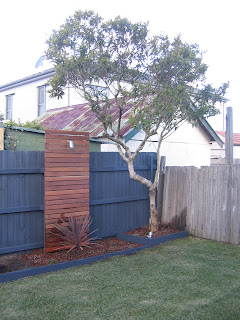Well spring has certainly sprung in Sydney! The warm weather is wonderful although we have already had a taste of the extreme winds that hit Sydney throughout the warmer months. Now that the soil is warming up it's time to think about getting into the garden.
Maybe you've thought about paving or decking a small area to create an outdoor dining space, or putting in a vegetable patch to grow your on herbs and veggies for summer salads. Whatever your plans, it's time to get started so you can enjoy the 'fruits' of your labour through summer!
This is also a great time of year to think of adding colour and shade to the garden. Many city gardens are 'compact' and owners believe they are too small for trees which might take over a garden. In fact, trees are a wonderful asset to any garden, and flowering trees can be quite spectacular; planted either as a single specimen or en-masse!
One of my favourite flowering medium trees for the suburban garden is the Largerstromia sp. or Crepe Myrtle. The 'Indian Summer' series are very pest resistant and produce beautiful sprays of flowers throughout the summer.
The colours range from pure white through pinks to vivid reds. Used throughout Sydney as a street tree, this is a testament to the fact that this tree is hardy and drought tolerant. It's the ideal tree to add summer colour to smaller Sydney gardens.
If your after flowers you can't go past blossoms! Cherry blossoms, apple blossoms, plum blossoms.....
This spectacular white flowering cherry is Prunus 'Yoshino'. This tree will do well in the cooler areas such as the Blue Mountains and Southern Highlands. If your looking for something that will cope with the humidity of coastal Sydney then try Prunus cerasifera 'Nigra'. Growing to 5m high and 4m wide, this tree has incredible blackish-purple foliage and abundant pink flowers in late winter to spring.
Other trees ideal for the suburban Sydney garden are the Jacaranda with it's mauve flowers in October, the Illawarra Flame Tree (pictured below) with it's fire-engine red flowers sprays, the beautiful evergreen miniature Magnolia 'Little Gem' and even though they are a little expensive, the Corymbia hybrids 'Summer Pink' and 'Summer Beauty' are spectacular flowering miniature gums perfect for smaller gardens.
There are also many trees not specifically grown for their flowers that are ideal for the Sydney climate. Olea europaea the 'European Olive' is drought tolerant and relatively pest free. Betula sp. such as the White Birch looks great planted as a small grove, as does the medium sized Paperbark Tree, Melaleuca quinquenervia which is native to the eastern coastal regions of Australia. This species is identified by the the 'papery' sheaths of bark which give the tree great character.
There are hundreds of small to medium growing trees suitable for smaller Sydney gardens. Making the right choice is essential; how high with it grow? What is the width of the mature canopy? Is it deciduous or evergreen and how will this affect the amount of light coming into your garden at different times of the year? Is it suitable for a coastal climate or will it withstand the cold if your in the mountains or the highlands?
A good idea is to look at trees used in your street-scapes of growing well in your neighbours gardens, this will give you a good idea of what will work in your own garden!
So get down to your local garden centre or community nursery and see what trees are on offer. Pick out something that will add height and colour to your garden. When planting remember to dig the hole twice the size of the pot the tree comes in. Add some compost to the hole as you back-fill and water in well, adding a seaweed tonic to help settle your new tree in. Make sure you keep the water up initially as the tree settles in, but it should soon be thriving on its own without any supplementary watering.
Go outside, enjoy the spring sunshine, and get gardening!

















































